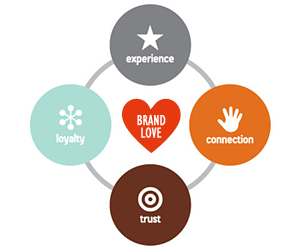Protected: Accessibility and Inclusivity: Libraries, Social Media, & Persons With Disabilities
Enter your password to view comments.
Filed under Uncategorized
Protected: Thinking about the final project
Enter your password to view comments.
Filed under Uncategorized
Libraries, Social Media, and Brand Love
For my Collection Development class here at UBC, I read an article by Susan Starr called “Creating Brand Love for Libraries: Can We Be a Kind of Paradise?” The article explores what “brand love” means and raises the question of whether it is possible for libraries to inspire brand love. I thought of Social Media class right away because it seems like there is a lot of potential for social media to play a major role in the development of brand love by libraries and similar institutions.
Starr writes that “brand love is characterized by a sense of natural comfort and fit, a feeling of emotional connectedness and bonding with the brand, a deep integration of the brand with a consumer’s core values, a heightened level of desire and interaction, and a commitment to the brand’s long term use” and points out that these are all valuable associations that library professionals would like users to make with our libraries.
But, Starr argues, libraries are doing branding wrong. They currently focus on the extrinsic rewards that libraries offer, such as access to information, a space to study, et cetera. But they are missing out on marketing the intrinsic rewards of libraries: the emotions or qualities that they spark, the basic pleasure that people get from using the “product” of libraries.
This leads to the question, what are the intrinsic rewards of library use? Starr points out that “loved brands create positive feelings such as happiness, admiration from others, control of one’s life, and so on.” As a health librarian, Starr thinks that feelings of control could be associated with her library, because of the idea that students who use library resources and study in the library have increased confidence and better performance in school. More than that, however, I think that an intrinsic reward of libraries is that libraries can contribute to an individual’s sense of self-identity and build a feeling of community. When you enter a library, sign up for a card, browse books, hole up at a study table, attend a program, or engage in the hundreds of other services that libraries offer, you are automatically a library user – and you are automatically a member of a broader community of library users. This intrinsic reward can be harnessed when libraries use media to market themselves and foster brand love.
So what happens after a library or other organization distinguishes a good intrinsic reward that they can use to encourage greater brand love? How does this play out on social media? The Purely Branded article From Like to Love: Brand and Social Media breaks some of these things down. One of the most important things is that organizations should use social media to create conversations with people who are already interested in and passionate about brands. Through these conversations, brands can create a social environment that stimulates a sense of belonging. In turn, this will lead to people having a significant sense of loyalty to a brand, repeatedly return to the brand, and recommend the brand to a friend.
I turned to Twitter to see if libraries were talking about brand love online. #Brandlove turns up a lot of tweets, but there are no results when searching #library and #brandlove together. However, #librarylove turns up a plethora of results – a lot of what people are doing when they are tweeting #librarylove is expressing their affinity for the library as a brand. One excellent example of this is an informal series of tweets by Calgary Public Library users in which they share photos of their library cards and discuss their attachments to the cards, noting nostalgic memories that they associate with the cards. This is uncannily similar to user-generated tweets that are tagged #brandlove, such as tweets where people share photos of Dairy Queen blizzards, comfortable airplane seating, and even deodorant.
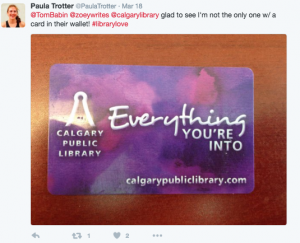
#Librarylove at work
The difference here is, however, that it is not a library that is starting this conversation about #librarylove – it is organic and coming from users themselves. After having identified their particular intrinsic value such as contributing to somebody’s sense of belonging, libraries have a potential to take a cue from other brands as well as library users and lead conversations about #librarylove.
*insert Goodreads pun here*

My Goodreads shelf
Lately I’ve had a lot of “Be my friend on Goodreads” emails come into my mailbox as my library school classmates are connecting with each other on the site. Because of this, I’ve become very interested in how people – and institutions! – use Goodreads to complement their online presence. I’m a semi-active Goodreads user; I use it to keep track of the books I read, but I only log on sporadically because most of my reading is (unfortunately) done over school breaks and I don’t write reviews. Even from my irregular use of the site, I can tell that it is a great place to get book recommendations from authorities you trust and strengthen social ties among friends, classmates, and even strangers.
Contrasting my relationship with Goodreads with those of my peers and other users, I began to wonder – have academics studied Goodreads in the context of how libraries can make use of this specific site? If so, what have they found? This is the perfect opportunity for me to put my own academic hat on and do some digging.
I turned to the trusty UBC library homepage – one of the best ways to satisfy scholarly questions and whims – and did a basic search for Goodreads I was very impressed with my findings – over 200 articles came up, which I was able to filter down to a manageable number of articles that answered my question. Here is my favorite article of the bunch – it has a fresh voice and is meticulously researched.
Finding Good Reads on Goodreads by Barry Trott and Yesha Naik, published in Reference & User Services Quarterly in 2012, talks about the ways that Goodreads can be used in libraries with a focus on how it can enhance reader’s advisory. The most important take-away is that Goodreads is a great way to bring the library out into the online environment where patrons are already congregating rather than waiting for patrons to come to the library’s website.
They point to two ways that public libraries can take advantage of Goodreads. First, public libraries could teach their patrons how to use Goodreads as a reader’s advisory tool for themselves. That way, “when patrons find the Goodreads page about a particular book they enjoyed, they are exposed to a RA goldmine: discussions about other books and authors, many of which are comparisons made between these books and authors and the original book”
A second way that libraries can use Goodreads is by creating an account for their library. They say that “the more the librarians post on their Goodreads account, the more they will be building a reputation for being a good source of information for reading suggestions.” Having a Goodreads presence can do more than allow libraries to recommend books: a Goodreads page is also an opportunity to boost a library’s brand, showcase library services, and demonstrate to community members that they are welcome in the library.
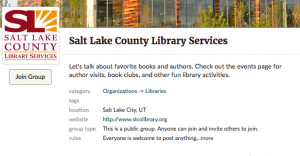
Inviting patrons into the library through Goodreads
The authors point to the Salt Lake County Library Services page on Goodreads as an especially dynamic model of how libraries can take advantage of the affordances of the site. You can check out their page here to see the intersection of libraries and Goodreads in action!
I also found that Sacramento Public Library has an excellent Goodreads page, which they bill as “A virtual space for the Sacramento Public Library community to discover and talk about books.” I was especially impressed with their discussion threads, including one called “Let’s Talk About Racism.” They used this thread to advertise an upcoming event as well as to recommend a book and give patrons an opportunity to weigh in with their opinions about the book.
For those looking to read a broader view about Goodreads and libraries, I recommend a Library 559M UBC wiki page about Goodreads that has an excellent background on the history of Goodreads, the ways that libraries can use it, and some controversies.
And finally, an invitation: be my friend on Goodreads! Expanding my network there would a great first step to being more active on the site and engaging with the Goodreads library community.
Filed under Uncategorized
#Twitter and Librarian Community Building
Busy week = quick blog post, but I was so inspired by a recent class discussion about how social media platforms can be used by library professionals to provide support for each other that I wanted to jot something down. After this discussion, and a visit by a Hootsuite Social Media Coach who shared the importance of using smart hashtags to get increased benefits out of your use of Twitter, I looked up popular hashtags that librarians use to share their experiences and communicate with each other on Twitter. I’ve put a lot of thought into the ways that library professionals can use hashtags to connect with the public, so this was a really interesting new way of thinking.
Dive Into the World of Library Hashtags, a Techsoup blog post by Ginny Miles, identifies the most frequently used of these hashtags, including #librarylife, #satudaylibrarian, #librarianproblems, #lovemylibrary, and #inaljchat. I’ll share some of my favourites from the bunch soon and comment on their connections with theory, but I recommend that anyone who is interested should check them out. Very relatable – especially #inaljchat! (In related news, does anybody want to give me a summer job?)
Filed under twitter
Social Media and #MMIW: Creating and Documenting News
Social media is not only featured in the news – it often creates news and becomes a news source in and of itself. One outstanding example of this that originated right here in Canada is found on Twitter: #MMIW. This begins with something seemingly simple that is deeply important: a hashtag.
One of the most striking things that I have learned this semester is that the hashtag was not a built-in feature invented by Twitter – it was created by a regular person. One reading for class, “Social Media and Library Services” by Lorri Mon, published by Morgan & Claypool Publishers in 2015, explains the root cause of why users needed hashtags after the adoption of Twitter. It’s all about finding and organizing information.
Mon writes, “standard “searchbox” features within social sites often function poorly, which makes alternative social organizing and finding features even more critical – if they don’t exist, users may invent them as happened with the development of the hashtag by Twitter users. Hashtags on Twitter as a user-created innovation are attributed to Chris Messina, who in 2007 suggested using them on Twitter as a way to be able to find threads of related messages and to hold larger conversations involving many users” (7). More readings about the history of hashtags can be found on About.com and Hashtag History.
Of course, hashtags have fantastic affordances when adopted by libraries. As Mon explains, “adding a popular hashtag on the library’s messages can also make postings more “findable” by desired user audiences on Twitter, taking advantage of Twitter’s user culture in reaching a wider audience.” Mon suggests certain hashtags that are associated with days of the week that libraries could use, including #MusicMonday, #ThrowbackThursday, #Caturday, and even #SelfieSunday (14). But how can libraries use hashtags for serious purposes? Can libraries be part of change-making hashtags like #MMIW, or are they confined to light-hearted, uncontroversial hashtags like #Caturday?
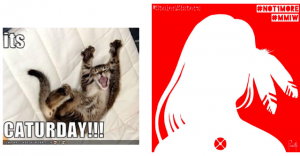
Typical results of Twitter searches for #Caturday and #MMIW
The hashtag #MMIW stands for the phrase “missing and murdered Indigenous women,” which refers to a human rights crisis across Canada. Almost 1,200 indigenous women and girls have been killed or are missing under suspicious circumstances across Canada, according to a 2012 Royal Canadian Mounted Police report. In a scathing report about the Canadian government’s lack of response to the crisis of missing and murdered Indigenous women, Amnesty International cites statistics that say Indigenous women are four times more likely to be murdered than non-Indigenous women. The government’s lack of response to this epidemic has been criticized by international human rights organizations such as the United Nations and the Inter-American Commission on Human Rights.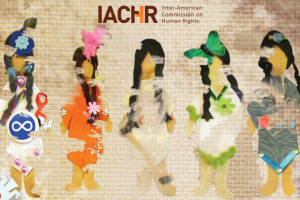
The hashtag originated with Grand Chief Sheila North Wilson, an indigenous woman who is an advocate for First Nations people in Manitoba, who created the hashtag as a way of raising awareness about tackling violence against Indigenous women. #MMIW has now become adopted into the common lexicon of how both activists and the broader public talk about this epidemic on social media. Google searches of #MMIW lead to tens of thousands of news articles about the topic. For example the CBC, the Huffington Post, and Global News all use the hashtag to classify articles about the topic. On Valentine’s Day, marches and vigils in the honour of the memory of missing and murdered Indigenous women were held throughout Canada, and participants and media used #MMIW to document the day’s activities and educate the public about the cause.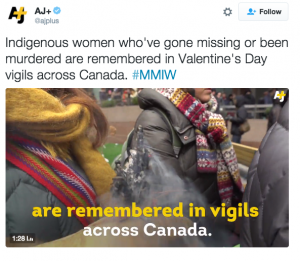
A cursory search of the Vancouver Public Library and University of British Columbia Library‘s Twitter accounts show that they have yet to use the #MMIW hashtag. Perhaps, as two of the many libraries located on the traditional and ancestral territory of the xʷməθkʷəy̓əm (Musqueam) people, they can be leaders in this respect and find ways to utilize #MMIW and other hashtags created by activists who aspire to use social media to create social change.
A cautionary tale?

I was looking through Vancouver Public Library’s Instagram and I noticed a pretty great comment on one of their first posts. A very kind commenter advises “I’d stick with the #vancouverpubliclibrary hashtag as the acronym has a whole different meaning.” Lo and behold, a search for #vpl on Instagram does yield results that are not related to Vancouver Public Library (and warning: are mostly not safe for work). Vancouver Public Library has refrained from using the #vpl hashtag in its following posts.
While this is not nearly on par with other social media pratfalls that organizations have made, it definitely illustrates the importance of reviewing all aspects of your organization’s social media posts before deciding to hit the share button!
Filed under Instagram
#LISMentalHealth: a conversation that we need to have
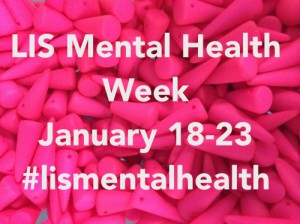 Librarians and bloggers Cecily Walker and Kelly McElroy founded the first-ever Library & Information Studies Mental Health Week in late January of this year. Using the twitter hashtags #LISMentalHealth and #LISMentalHealthWeek, people shared stories about their experiences with mental health challenges while working in the library field. Here are three of my favourite blog posts that were shared throughout the conversation.
Librarians and bloggers Cecily Walker and Kelly McElroy founded the first-ever Library & Information Studies Mental Health Week in late January of this year. Using the twitter hashtags #LISMentalHealth and #LISMentalHealthWeek, people shared stories about their experiences with mental health challenges while working in the library field. Here are three of my favourite blog posts that were shared throughout the conversation.
Tips for Being Functional by Ruby Warren
Ruby Warren writes about her experiences with mental illness and gives tips about functioning with work stressors as a mentally ill professional. These include: knowing your triggers, planning for your brain “to not work sometimes”, training yourself to believe that done is good enough, and not being afraid to use sick days when you need them.
For me, the highlight was when she talks about the importance of “getting your head out of your navel” in the workplace. I’m going to quote her paragraph in entirety because I think that it is incredibly profound.
“We get way high on what we do in libraries, and libraries are way cool, but ten people being annoyed because I forgot to change a font colour is not the town mob that my anxiety is making it out to be. Sometimes, when I’m stressed out over a new project and feel like a fraud or whatever, I like to sit and imagine a world where no one did my job. Things would be worse, granted, but… the world would keep going. My university would keep going. My library would keep going. And that’s ultimately super friggin freeing. Because the worst case scenario is that someone does nothing, and even then nobody’s going to die or truly suffer for it. And even at my super depressed-est, even I have to acknowledge that I can totally do better than a non-existent person doing nothing.”
Keeping Our Own Time by Emily Drabinski
Emily Drabinski talks about her struggles with burnout and procrastination as an academic librarian and how getting tenure has alleviated this burnout. She is able to “write nothing! coast awhile!” because she has tenure, and now is able to focus on what is really important to her in the field of librarianship and the scholarly studies that she engages with in the field.
She concludes with advice to librarians who are struggling with burnout, which is also very applicable to library students who find themselves struggling to identify the meaning behind their hectic, fast-paced studies. “Find something inside the field that matters, and then do your best to set your watch by it.” Personally, this advice strikes a cord with me and reminds me why I am pushing myself to seek out topics of research and study within my courses that relate to my broader interests and the change that I want to see in the world. I am very lucky to have been able to do this in my courses this semester, and am optimistic that I will be able to keep this up throughout my time at SLAIS.
Mental Health Micro-Aggressions by Rebecca Ciota
Rebecca Ciota takes an unconventional approach to the #LISMentalHealth conversation – rather than focusing on the mental health of library professionals, she discusses the ways in which library employees can support patrons who have mental health disorders. Rebecca gives examples of insulting and ignorant comments that she has witnessed library employees say in reference to library patrons.
She concludes that:
“As we use #LISMentalHealthWeek to discuss our own mental health issues and share support, I hope we (the library community) can also try to renew our commitment to making libraries a safe space for everyone. We should be aware of the things we say and do, and how that shapes a safe (or hostile) environments for our coworkers and patrons.”
I was late on the #LISMentalHealthWeek bandwagon, but luckily the January conversations can be found on Twitter by searching the two hashtags, and conversation continues to be ongoing. I highly encourage everyone to check out the hashtags and see this great example of how social media can be used within the library community to inspire others, build solidarity, and create change.
Filed under twitter, Uncategorized
Hello UBC!
I am in my second semester of the MLIS program at UBC. I’m originally from the great Commonwealth of Virginia, right outside of Washington D.C. After high school I studied Women’s Studies and Spanish at Wellesley College, a women’s college outside of Boston. While at Wellesley I studied abroad in Puebla, Mexico and was a barista at a feminist co-op cafe. After college I kept busy for three years: I taught English in Mexico City through a State Department program, interned in the development department of a national nonprofit, and worked in circulation at (in my opinion) the best public library in the world. I’m very passionate about libraries (not surprising), social justice, and everything LGBTQ+.
I’m an avid social media user. I got on Facebook in 2006, back when you still needed a personal invite to join, and I continue to be quite active today. I use it to engage with political causes and connect with friends from Virginia, college, Mexico, as well as my family – my mom is obsessed with the site! I also frequently use Instagram and Snapchat to interact with my friends (a lot of selfies and pictures of my cat). I use twitter to keep up with current events and follow my favorite comedians.
This is actually my second blogging experience – I also kept a blog during my third year of university, when I was studying abroad in Mexico. With the clever name of Claire in Mexico, the blog helped me keep in touch with my family and classmates, as well as providing a valuable record of my experience. I had a lot of fun with the blog, and I am looking forward to having another reason to blog again through this class!

